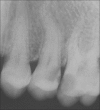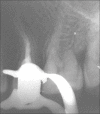Managing curved canals
- PMID: 22919234
- PMCID: PMC3425117
- DOI: 10.4103/0976-237X.96842
Managing curved canals
Abstract
Dilaceration is the result of a developmental anomaly in which there has been an abrupt change in the axial inclination between the crown and the root of a tooth. Dilaceration can be seen in both the permanent and deciduous dentitions, and is more commonly found in posterior teeth and in maxilla. Periapical radiographs are the most appropriate way to diagnose the presence of root dilacerations. The controlled regularly tapered preparation of the curved canals is the ultimate challenge in endodontics. Careful and meticulous technique will yield a safe and sufficient enlargement of the curved canals. This article gives a review of the literature and three interesting case reports of root dilacerations.
Keywords: Balance forced technique; dilacerations; precurved files; protaper.
Conflict of interest statement
Figures
References
-
- Jafarzadeh H, Abbott PV. Dilaceration: review of an endodontic challenge. J Endod. 2007;33:1025–30. - PubMed
-
- Hamasha AA, Al-Khateeb T, Darwazeh A. Prevalence of dilaceration in Jordanian adults. Int Endod J. 2002;35:910–2. - PubMed
-
- Jain N, Tushar S. Curved canals: ancestral files revisited. Indian J Dent Res. 2008;19:267–71. - PubMed
-
- Wiene FS. Endodontic therapy. 6th ed. St Louis: Mosby; 2004.
-
- Saunders EM. Hand Instrumentation in root canal preparation. Endodontic Topics. 2005;10:163–7.








